AC contactor wiring diagrams are essential for understanding how to install, troubleshoot, and maintain electrical systems. They provide a visual representation of connections, ensuring safety and efficiency. Always follow diagrams for proper configuration and compatibility with your equipment.
1.1 What is an AC Contactor?
An AC contactor is an electrical switch designed to control the flow of alternating current (AC) in circuits. It is commonly used to connect and disconnect electrical loads, such as motors, compressors, or lighting systems. Unlike circuit breakers, contactors are not protective devices but rather control devices that enable remote operation. They consist of an electromagnet coil, contacts, and an enclosure. When the coil is energized, the electromagnet attracts the contacts, allowing current to flow through the circuit. AC contactors are essential for starting and stopping motors in HVAC systems, industrial machinery, and other high-current applications. Their ability to handle high current levels while being controlled by low-power signals makes them a fundamental component in electrical systems. Proper understanding and wiring of AC contactors are crucial for safe and efficient operation. Always refer to wiring diagrams for specific configurations and compatibility with your equipment.
1.2 Importance of Wiring Diagrams for AC Contactors
Wiring diagrams for AC contactors are essential guides for installing, maintaining, and troubleshooting electrical systems. They provide a clear visual representation of connections, ensuring that components are linked correctly and safely. By following a wiring diagram, technicians can avoid errors that might lead to system malfunctions or safety hazards. These diagrams are particularly crucial for complex systems, such as HVAC configurations, where multiple components like thermostats, transformers, and compressors must work in harmony. They also help in identifying the correct wire sizes, voltage requirements, and safety protocols, such as turning off power before starting work. Additionally, wiring diagrams are invaluable for selecting compatible devices, as they highlight specifications for contactors, overload relays, and starters. Using a wiring diagram ensures compliance with electrical standards and prevents issues like short circuits or overloaded systems. Always refer to manufacturer-provided diagrams for accuracy and safety.

Understanding the AC Contactor
An AC contactor is an electrical switch that controls the flow of alternating current in circuits. It is widely used in motor control applications and HVAC systems to manage power distribution efficiently and safely.
2.1 Key Components of an AC Contactor
An AC contactor consists of several essential components that enable its operation. The primary elements include the coil, which generates a magnetic field when energized, and the contacts, which are the electrical connections that open or close the circuit. The poles determine the number of circuits the contactor can control, typically ranging from 2 to 4 poles. Another critical component is the arc chute, which extinguishes the electric arc formed when contacts open or close. The enclosure houses all these parts, providing mechanical protection and ensuring safe operation; Understanding these components is crucial for interpreting wiring diagrams and ensuring proper installation and maintenance. Each part plays a vital role in the contactor’s functionality, making it essential to familiarize yourself with their roles and interactions within the system.
2.2 How AC Contactors Work
An AC contactor operates by using electromagnetic principles to control the flow of electrical current in a circuit. When a control signal is applied to the contactor’s coil, it generates a magnetic field, causing the movable contacts to shift position. This movement either connects or disconnects the circuit, allowing the contactor to switch loads on or off. The process begins with the energization of the coil, which attracts an iron core, moving the contacts mechanically. Auxiliary contacts are often used to provide feedback or control signals to other devices in the system. Once the coil is de-energized, a spring returns the contacts to their original position, breaking the circuit. The arc chute ensures safe arcing during contact opening, preventing damage to the contactor. This operation is essential for controlling high-power devices in industrial and residential settings, making AC contactors a fundamental component in electrical systems.
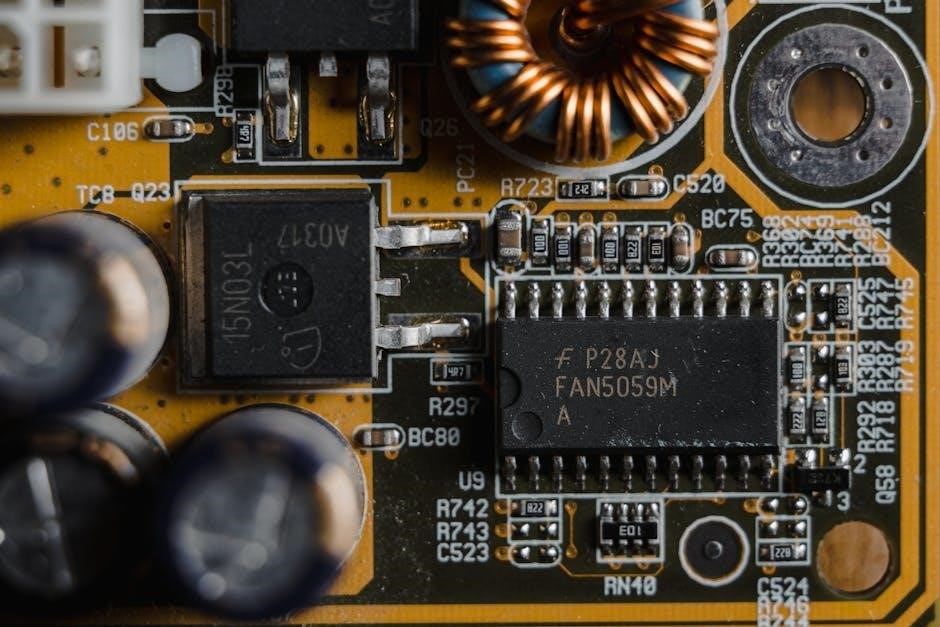
Reading AC Contactor Wiring Diagrams
Understanding AC contactor wiring diagrams involves interpreting symbols, connections, and the overall circuit layout. These diagrams provide a visual representation of how components are connected, ensuring proper installation and operation of the contactor in electrical systems.
3.1 How to Interpret AC Contactor Wiring Diagrams
Interpreting AC contactor wiring diagrams requires a systematic approach to understand the electrical circuit and connections. Start by identifying the key components, such as the contactor, coil, and auxiliary contacts, and their positions in the diagram. Look for standard symbols like lines representing wires, circles for contacts, and coils for electromagnetic components.
Next, trace the power supply lines to understand how voltage is applied to the contactor. Identify the control circuit, which includes the coil and any auxiliary contacts, to determine how the contactor is activated. Pay attention to labels and annotations, as they provide critical information about voltage levels, wire sizes, and connection points.
Finally, cross-reference the diagram with the manufacturer’s specifications to ensure all connections match the recommended wiring configuration. This step-by-step approach ensures accurate installation and operation of the AC contactor in the electrical system.
3.2 Common Symbols and Notations Used
AC contactor wiring diagrams use standardized symbols and notations to represent components and connections. The most common symbols include lines representing wires, circles for contacts, rectangles for the contactor itself, and coils to denote electromagnetic components. Auxiliary contacts are often shown as small circles with lines indicating their state (normally open or closed).
Additional notations include voltage ratings, wire sizes, and terminal labels, which are crucial for proper installation. These symbols ensure clarity and consistency, allowing technicians to quickly identify components and their functions. Understanding these symbols is essential for accurately interpreting and wiring AC contactors.
By following these notations, technicians can ensure that the wiring matches the manufacturer’s specifications, reducing the risk of errors and ensuring safe operation. These symbols are universally recognized, making AC contactor wiring diagrams accessible to professionals worldwide.
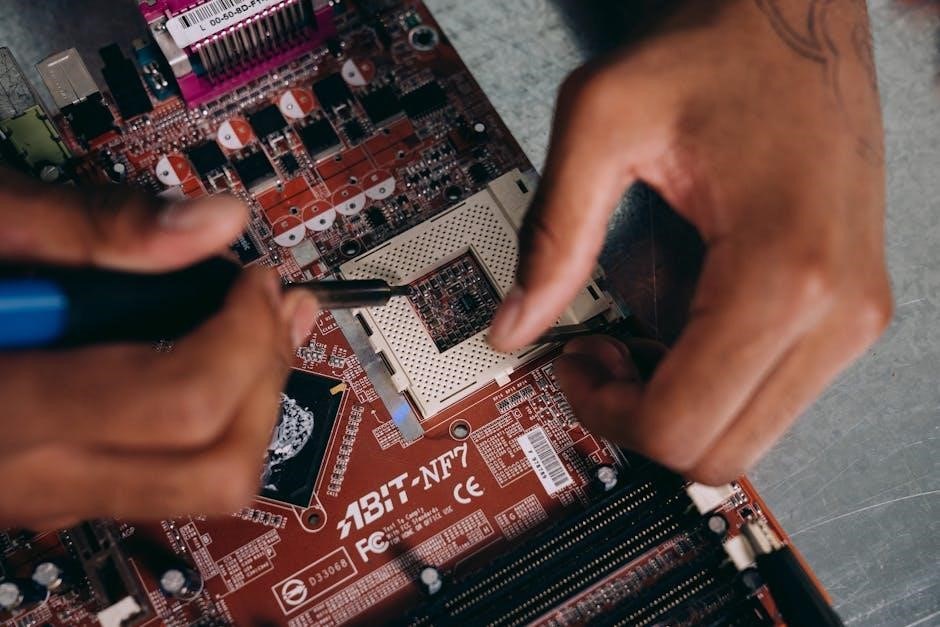
Selecting the Right AC Contactor
Selecting the right AC contactor involves considering voltage, current, and horsepower ratings to ensure compatibility with your system. Choose based on application type, such as motor control or lighting, and ensure the coil voltage matches your control circuit. Prioritize brands with a reputation for reliability and durability, and verify certifications like UL listing for safety compliance.
4.1 How to Choose the Right AC Contactor for Your Needs
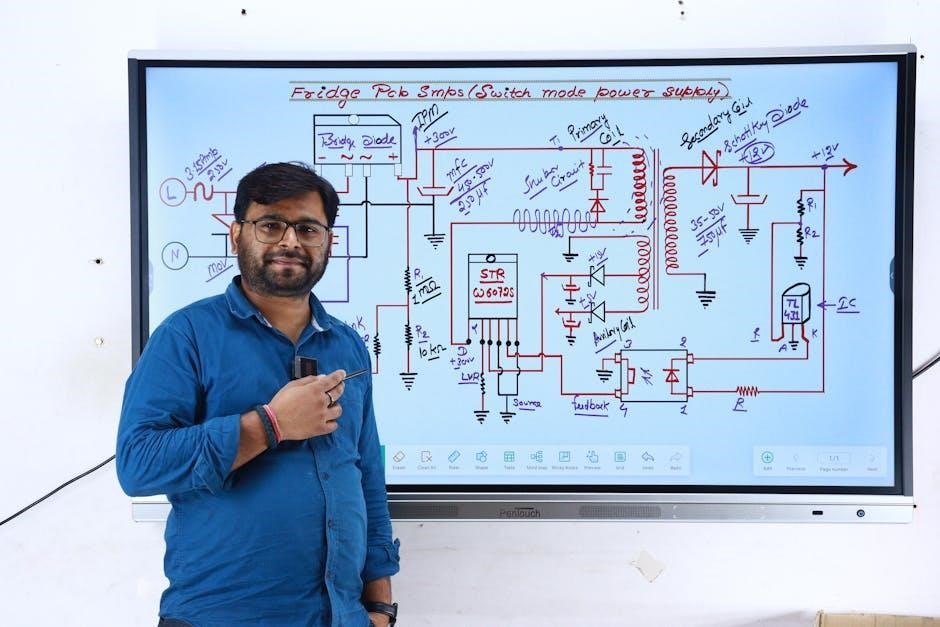
Choosing the right AC contactor begins with understanding your specific application requirements. Start by identifying the voltage and current ratings needed for your system, ensuring the contactor can handle the load without overheating. Consider the horsepower rating if controlling motors, as undersizing can lead to premature failure. Additionally, think about the coil voltage, which must match your control circuit voltage to ensure proper operation. Selecting the correct pole configuration (e.g., 2-pole or 4-pole) is also crucial for compatibility with your electrical system. Referencing an AC contactor wiring diagram PDF can help you understand the terminal connections and wiring requirements. Finally, consider environmental factors like ambient temperature and humidity, as these may influence the contactor’s performance and durability. Always opt for a contactor with appropriate certifications, such as UL listings, to ensure safety and compliance with industry standards.
4.2 Voltage and Current Ratings
Voltage and current ratings are critical when working with AC contactors, as they determine the device’s compatibility with your electrical system. Always match the contactor’s voltage rating to the supply voltage of your circuit to ensure proper operation. The current rating must be sufficient to handle the maximum load current, including any startup surges for motors. Underrating the contactor can lead to overheating and premature failure, while overrating may result in unnecessary costs. Refer to the AC contactor wiring diagram PDF to identify the rated voltage and current for each terminal. Additionally, consider the coil voltage, which powers the contactor’s electromagnet, ensuring it matches your control circuit’s voltage. Proper alignment of these ratings ensures safe and efficient operation, preventing potential hazards like electrical fires or system malfunctions. Always verify the ratings against your application’s requirements before installation.

Installation Steps for AC Contactors
- Ensure the power supply is disconnected before starting the installation.
- Mount the contactor securely on a suitable surface.
- Connect wires according to the AC contactor wiring diagram PDF.
- Test the circuit to ensure proper functionality.
- Follow safety guidelines to avoid electrical hazards.
5.1 Step-by-Step Installation Guide
Installing an AC contactor requires careful planning and adherence to the wiring diagram. Begin by disconnecting the power supply to ensure safety. Mount the contactor on a flat, stable surface, securing it with screws. Next, identify the terminals on the contactor and match them to the wiring diagram. Connect the line voltage wires to the designated L1 and L2 terminals. Attach the load wires to the T1 and T2 terminals, ensuring proper polarity. If a control circuit is involved, connect the wires according to the diagram, typically involving a coil and auxiliary contacts. Double-check all connections for accuracy. Finally, restore power and test the contactor by energizing the control circuit to verify proper operation. Always refer to the AC contactor wiring diagram PDF for specific instructions tailored to your model. Following these steps ensures a safe and reliable installation.
5.2 Wiring Tips and Best Practices
When working with AC contactor wiring, following best practices ensures safety and reliability. Always use the correct wire size to handle the rated current, as specified in the AC contactor wiring diagram PDF. Secure wires tightly to prevent movement, which could cause wear or arcing. Use a voltmeter to verify voltage levels before connecting wires to avoid electrical shocks; Ensure all connections are clean and free of oxidation for optimal conductivity. Tighten terminals firmly but avoid over-tightening, which may damage the contactor. Label wires clearly for easy identification during future maintenance. Cross-reference the wiring diagram with the physical setup to confirm accuracy. Double-check the phase sequence to match the equipment requirements. Test the circuit step-by-step before full operation to identify any issues early. Always adhere to local electrical codes and safety standards. By following these guidelines, you can ensure a safe and efficient wiring process for your AC contactor system.

Troubleshooting AC Contactor Issues
Identify issues like coil failure or misalignment by consulting the AC contactor wiring diagram PDF. Check for loose connections, incorrect voltage, or faulty wiring. Ensure proper alignment of moving contacts. Verify coil resistance and power supply. Address buzzing or overheating promptly. Use the diagram to trace circuits and isolate faults efficiently.
6.1 Common Issues and Troubleshooting Tips
When working with AC contactor wiring diagrams, common issues include coil failure, misalignment of moving contacts, and loose connections. Consult the diagram to identify these problems. Coil failure often results from incorrect voltage or power supply issues. Check resistance and ensure proper power supply. Misaligned contacts can prevent proper operation; refer to the diagram to realign them. Loose connections are a frequent cause of malfunction; tighten all terminals. Buzzing or overheating may indicate worn contacts or overload; inspect and replace worn parts. Faulty wiring is another issue; use the diagram to trace circuits and verify connections. Always ensure the contactor is correctly rated for voltage and current. Regular maintenance, such as cleaning contacts, can prevent many issues. If problems persist, consult the manufacturer’s guidelines or seek professional assistance. Proper troubleshooting ensures safe and efficient operation.
6.2 Maintenance and Safety Tips
Regular maintenance is crucial for ensuring the longevity and efficiency of AC contactors. Always inspect the contacts and coils for signs of wear or damage. Clean the contacts periodically using a soft cloth or specialized contact cleaner to remove dirt and oxidation. Lubricate moving parts if recommended by the manufacturer. Ensure all wiring connections are secure and free from damage. Refer to the AC contactor wiring diagram to verify connections and avoid mismatches. Always de-energize the circuit before performing any maintenance or repairs. Use personal protective equipment (PPE), such as insulated gloves and safety goggles, to prevent electrical shocks or injuries. Check for overheating issues by monitoring the contactor’s temperature during operation. Replace worn or damaged parts promptly to prevent system downtime. Follow the manufacturer’s guidelines for maintenance intervals and safety precautions. Proper upkeep ensures reliable performance and minimizes the risk of electrical hazards.

Resources and References
Access official AC Contactor Wiring Diagram PDF from manufacturers’ websites or technical libraries. Online marketplaces like Amazon offer detailed guides. Forums and communities provide user-shared resources. Refer to the glossary for clarity on technical terms.
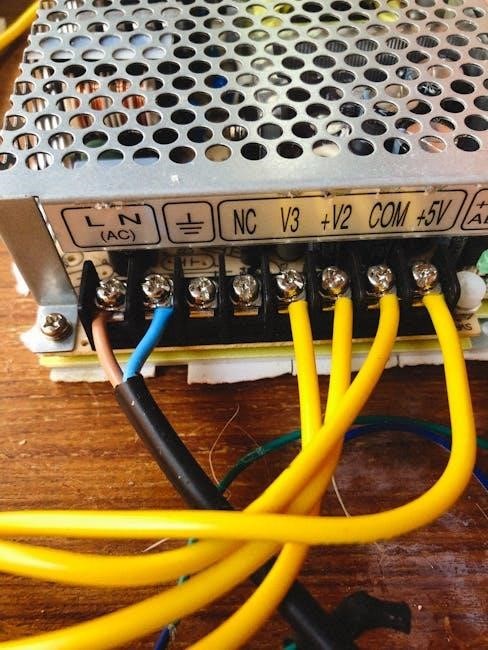
7.1 Where to Find AC Contactor Wiring Diagrams
AC contactor wiring diagrams are readily available from various reliable sources. Manufacturer websites, such as Schneider Electric, Siemens, or Eaton, provide official PDF downloads tailored to specific models. Technical libraries and online marketplaces like Amazon or eBay often include wiring diagrams in product descriptions or user manuals. Additionally, forums and communities dedicated to electrical engineering, like All About Circuits or Electrician Talk, frequently share user-contributed diagrams. Document-sharing platforms such as Scribd or DocShare.net may also host a wide range of PDF resources. Always ensure the diagrams are sourced from trusted providers to avoid counterfeit or incorrect information. For compatibility, verify that the diagrams match your contactor’s model and voltage rating. These resources are invaluable for safe and efficient installation or troubleshooting.
7.2 Glossary of Terms Related to AC Contactors
A glossary of terms related to AC contactors is essential for understanding their functionality and wiring diagrams. Key terms include AC Contactor, a device used to control the flow of electrical current in AC circuits. NO and NC Contacts refer to “Normally Open” and “Normally Closed” terminals, which define the contact’s state when the contactor is de-energized. Coil Voltage specifies the voltage required to energize the contactor’s coil, typically 24V, 120V, or 240V. Contactor vs. Relay highlights differences, with contactors handling higher currents and larger loads. Pole indicates the number of switching points, such as single-pole (SP) or double-pole (DP). Auxiliary Contacts are extra contacts used for signaling or controlling other circuit components. Understanding these terms helps in interpreting wiring diagrams accurately and ensures proper installation and troubleshooting. This glossary provides a foundation for working with AC contactors effectively.
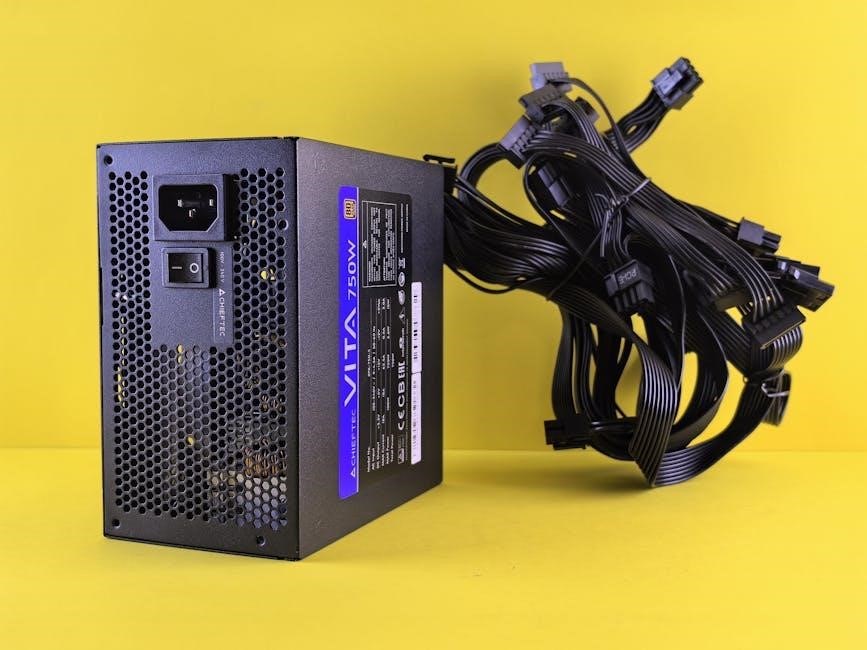
Mastery of AC contactor wiring diagrams ensures safe and efficient electrical system control. Proper installation and understanding enhance reliability and performance, making these diagrams indispensable for technicians and engineers. This guide provides a comprehensive roadmap for working with AC contactors effectively.
8.1 Final Thoughts on AC Contactor Wiring Diagrams
Understanding and utilizing AC contactor wiring diagrams is crucial for ensuring the safe and efficient operation of electrical systems. These diagrams provide a clear visual representation of how components are connected, simplifying the installation, troubleshooting, and maintenance processes. By mastering the interpretation of these diagrams, technicians and engineers can minimize errors and enhance system reliability. It is essential to always refer to the most up-to-date AC contactor wiring diagrams specific to the equipment being used, as they are tailored to meet the design specifications of the manufacturer. Additionally, adhering to safety guidelines and best practices when working with contactors is paramount to prevent electrical hazards. Regularly reviewing and updating knowledge on wiring diagrams ensures compliance with industry standards and optimizes performance. In conclusion, AC contactor wiring diagrams are indispensable tools that play a vital role in maintaining and improving electrical infrastructure.
